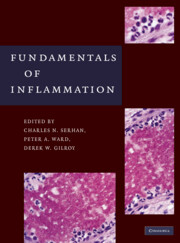Book contents
- Frontmatter
- Contents
- Contributors
- Preface
- PART I THE INFLAMMATORY RESPONSE – AN OVERVIEW
- PART II INDIVIDUAL CELL TYPES
- PART III CHEMICAL MEDIATORS
- 12 Lipid Mediators in Acute Inflammation and Resolution: Eicosanoids, PAF, Resolvins, and Protectins
- 13 Cytokines and Chemokines in Inflammation
- 14 Adenosine Receptors: Therapeutic Aspects for Inflammatory and Immune Diseases
- 15 Leukocyte Generation of Reactive Oxygen Species
- 16 Cell Adhesion Molecules
- PART IV IMMUNOPHARMACOLOGY
- PART V INFLAMMATORY DISEASES/HISTOLOGY
- PART VI ANIMAL MODELS OF INFLAMMATION
- Index
- References
16 - Cell Adhesion Molecules
from PART III - CHEMICAL MEDIATORS
Published online by Cambridge University Press: 05 April 2014
- Frontmatter
- Contents
- Contributors
- Preface
- PART I THE INFLAMMATORY RESPONSE – AN OVERVIEW
- PART II INDIVIDUAL CELL TYPES
- PART III CHEMICAL MEDIATORS
- 12 Lipid Mediators in Acute Inflammation and Resolution: Eicosanoids, PAF, Resolvins, and Protectins
- 13 Cytokines and Chemokines in Inflammation
- 14 Adenosine Receptors: Therapeutic Aspects for Inflammatory and Immune Diseases
- 15 Leukocyte Generation of Reactive Oxygen Species
- 16 Cell Adhesion Molecules
- PART IV IMMUNOPHARMACOLOGY
- PART V INFLAMMATORY DISEASES/HISTOLOGY
- PART VI ANIMAL MODELS OF INFLAMMATION
- Index
- References
Summary
BIOLOGICAL FUNCTIONS OF ADHESION MOLECULES
Cell adhesion molecules are endowed with many biological functions, often crucial to life. For instance, in gut or lung epithelia they assure cell-to-cell contacts, thus making and maintaining barrier functions, while allowing passage of nutrients and other solutes. Besides maintaining body form and structure, cell adhesion molecules play important roles in tissue development as well as helping to determine its final organization. A common feature of adhesion molecules is their ability to sustain strong bonds between adjacent cells on either a permanent or intermittent basis.
Apart from these static functions of cell adhesion molecules, there are many mobile functions, whereby they are able to induce intermittent cell-to-cell bonds hence assuring particular cell movements either in the blood vessel (as during inflammation; topic to be investigated in this chapter) or within tissues and organs.
It is therefore evident that, contrary to previous simplistic visions and predictions, cells are never free floating but rather they move on surfaces such as the inflamed joint or gut subepithelial strata, penetrate into injured organs or circuit the body (think of T cells traveling the blood lymphatic circulation, and so forth) by activating processes all relating to cell adhesion molecule-mediated phenomena.
Information
- Type
- Chapter
- Information
- Fundamentals of Inflammation , pp. 208 - 216Publisher: Cambridge University PressPrint publication year: 2010
